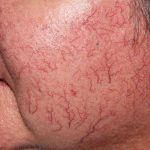 Permanent dilation of blood vessels near the surface of the skin or mucous membranes that results in small focal red lesions that are commonly seen on the nose, cheeks, and chin. Also called angioectasias or spider veins.
Permanent dilation of blood vessels near the surface of the skin or mucous membranes that results in small focal red lesions that are commonly seen on the nose, cheeks, and chin. Also called angioectasias or spider veins.
A condition in which the small blood vessels, especially in the face and thighs, are permanently dilated producing dark red blotches.
Increased size and number of blood vessels in the skin, causing redness, especially on the ears and face, sometimes (in hereditary forms) readily susceptible to bleeding. Telangiectasias sometimes occur simply from too much sunlight but are often associated with alcohol abuse and with disorders such as a hereditary form of ataxia and lupus erythematosus. Some kinds of birthmarks are a localized form of telangiectasia.
Localized collection of widened and distended capillaries and other small blood vessels, visible as a red spot that typically blanches on pressure. The spots may be found on the skin or mucous membranes.
Small, permanently dilated capillaries (small blood vessels) in the skin. Telangiectasias, which commonly appear on the nose and cheeks, cause redness. They can be symptoms of rosacea, elevated estrogen levels, liver disease, or collagen vascular disease. They may be treated cosmetically with lasers.
A vascular lesion formed by dilatation of a group of small blood vessels. It may appear as a birthmark or become apparent in young children. It may also be caused by long-term sun exposure. Although the lesion may occur anywhere on the skin, it is seen most frequently on the face and thighs.
Let us explore a distinctive characteristic that can be observed on the skin of the nose and cheeks small, visible blood vessels that traverse the surface. These delicate blood veins, commonly referred to as telangiectasia, manifest as fine red or bluish lines that become apparent due to their proximity to the skin’s surface. While their presence is typically harmless, they can contribute to certain cosmetic concerns. Understanding the nature and appearance of these small blood veins can aid in recognizing and addressing any underlying conditions or aesthetic considerations.
Telangiectasia, characterized by the enlargement of tiny blood vessels beneath the skin’s surface, leads to redness and a visible pattern resembling “broken veins.” This phenomenon typically occurs on the nose and cheeks. The emergence of telangiectasia might lack an apparent trigger, or it could be a result of prolonged excessive alcohol consumption, the skin ailment rosacea, excessive sun exposure, or a connective tissue disorder like dermatomyositis.
Telangiectasia typically doesn’t pose a worrisome threat. However, if its appearance is highly undesirable, there are certain instances where the veins can be eliminated. This can be achieved through techniques such as electrodesiccation (the use of electrical means to destroy the upper skin layers) performed by a dermatologist, or through laser treatment.
Expansion of tiny blood vessels in the skin. One variant appears as a web-like pattern of veins, often visible on the legs of middle-aged women.
